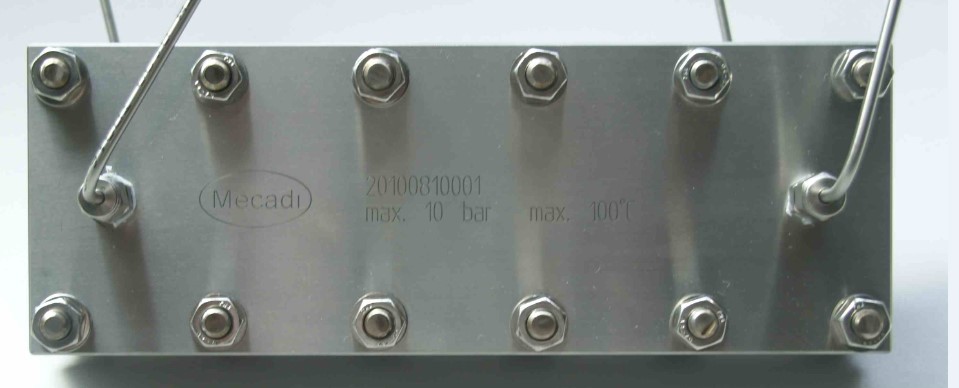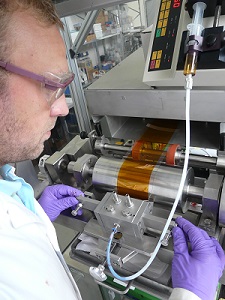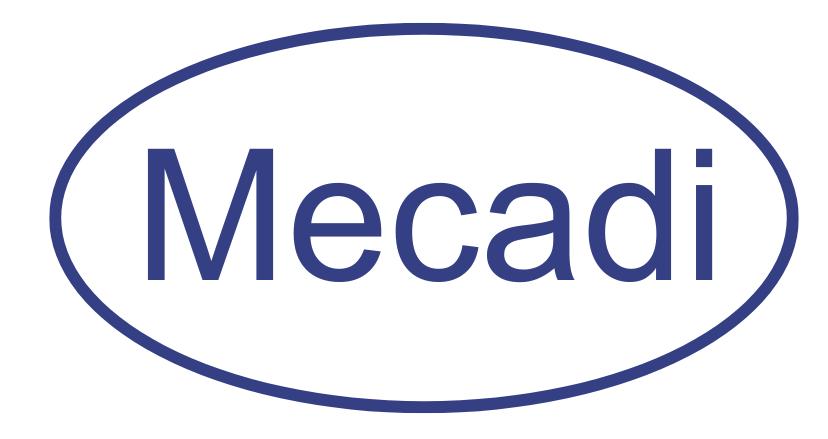Here you will find some references that Mecadi customers have published to give you an impression of the variety of our work in the field of permeation measurements. In total, Mecadi GmbH has carried out over 2000 customer projects in all major research and industrial sectors over the last 20 years.
Overview
Tecnoplast
Tecnoplast is a manufacturer of PTFE corrugated hoses. Due to the almost universal chemical resistance of PTFE, the hoses are also suitable for the fluid transfer of aggressive and corrosive media such as strong acids. Mecadi has examined the acid permeation for Tecnoplast in long-term tests over 125 days using concentrated nitric acid (65%) as an example. At the customer’s request, the corrugated hoses themselves were tested, despite the challenge of sealing them for the permeation measurement. However, this made it possible to make statements about the passage times for complex geometries without extrapolation and to take into account possible influences of production on the permeation close to the application. Permeation of nitric acid at room temperature only occurs after weeks or months. The permeation quantities are in the range of µg per day and running meter of hose and must be collected for permeation analysis. The permeation measuring device had to be protected from light, as otherwise algae growth would have reduced the recovery rate in the permeate chamber. To investigate whether quasi-stationary permeation had been achieved, the course of permeation over time was examined.
https://www.tecnoplast.de/de/service/download/?file=permeationsuntersuchung.pdf
PAGeotechnical
Protecting buildings from gas infiltration is one of the specialties of PAGeotechnical from England. Plastika Kritis S.A (Crete, Greece) is a manufacturer of PE geomembranes. A reduction of gas ingress into cellars, brownfield sites or tunnels can be achieved by passive protection devices in the form of barrier films. Polyethylene tarpaulins, for example, are used for this purpose. In the UK, there are building regulations that specify adequate precautions to prevent health and safety hazards caused by contaminants in the ground to be covered by buildings and associated ground. These contaminants can be of human or natural origin. Among other things, methane, carbon dioxide, radon or hydrogen sulphide can occur as gases, which then collect in basements. In this respect, the foils used should have low permeation for gases and should be installed without leaks at joints. Sensible limit values for permeation barriers or necessary material thicknesses can be calculated. Depending on the application, the necessary data includes Ex limits, odor thresholds, temperatures at which permeation takes place (temperature distribution over time due to temperature dependence of permeation), areas, volumes, air exchange rates and others.
Please contact us to receive the publication.
Gas Separation Membranes
Gas Separation Membranes (Polymeric and Inorganic) is a book published in 2015 and provides an overview of membrane-based separation processes for the separation of gases. After a historical overview and discussion of the advantages of membrane processes, the basic principles of gas permeation through porous and non-porous membranes are explained. Transport models for diffusion in rubbery and crystalline polymers and others are reviewed. Membranes of different materials and structures (e.g. mixed matrix membrane, carbon-based membrane, asymmetric membrane, liquid membrane, metal-organic framework membrane) and different fabrication methods (e.g. phase inversion, multilayer formation, hollow fiber spinning, precipitation by solvent evaporation) as well as processing into membrane modules and applications. Various membrane characterization methods including advanced methods such as positron annihilation are summarized. The characterization of membranes, test methods for mass transport (permeation, permeability, selectivity), morphology, behavior with temperature change and mechanics are also presented. The book also refers to the technology report published by Mecadi on the topic of carbon dioxide separation with membranes (http://technologiereport.mecadi.de/) based on scientific work by Dr. Andreas Konrad. The basic transport equations and measurement methods for membrane characterization as well as for gas separation with membranes became the technological basis of Mecadi GmbH.
https://books.google.de/books?isbn=3319010956
Curaray
Kuraray is a Japanese chemical company, EVAL Europe N.V. is a subsidiary based in Belgium. The company’s specialty polymers include low-permeation barrier materials. Mecadi has tested ethyl vinyl alcohol copolymers (trade name: EVAL™) for EVAL Europe for their permeability to hydrogen at various temperatures and pressures. These materials are known, among other things, as good barrier layers against gases (oxygen barrier in food packaging or underfloor heating pipes) or as a barrier against solvents (fuels in tanks). EVOH is also a very good gas barrier for hydrogen compared to other thermoplastics, which opens up potential applications for fuel cell applications or energy storage with hydrogen. The Mecadi measured values for hydrogen permeation at pressures up to 100 bar and comparative measured values for various thermoplastics are published in the brochure “Eval for hydrogen fuel cell systems” by Kuraray.
Please contact us to receive the publication.
German Agricultural Society
The DLG (abbreviation for German Agricultural Society) is an association of the German food and agricultural industry. At the DLG test center “Technology and Resources” in Groß-Umstadt, agricultural and municipal technology as well as agricultural resources are subjected to practical tests and evaluated with regard to their suitability. In cooperation with the DLG, Mecadi has tested films for gas storage tanks for their gas permeability (methane permeation). In the safety regulations for biogas plants of the agricultural trade association, a limit value for permeability in relation to methane is specified, particularly for plastic films, of < 1000 cm³ / (m² x d x bar) (section 2.4.1). The pressure specified in this unit refers to the partial pressure difference of methane between the inside and outside of the film and not to the overpressure prevailing in the bioreactor. At a methane content of 50 % (typical range for biogas: 50-75 % methane content), the partial pressure difference, which is the driving force for permeation (through the defect-free film), is 500 mbar (equivalent to 500 hPa). Deviating from this, the absolute pressure difference is the driving force in the event of leaks (defects, interfaces at sealing points). In normal operation, however, biogas plants are operated with low absolute pressure differences (a few mbar overpressure to the ambient pressure). From the limit values for the permeation of the film and the permissible leakage rates (Section 1.2.2. Safety rules), the contribution of permeation to the total methane loss of a biogas plant can be estimated at around 50 % (assumption: operation at 2 mbar overpressure, films and leaks at the limit value). The proportion of permeation becomes even more relevant if it is taken into account that permeation is strongly temperature-dependent. This means that a film that has been tested for permeation under laboratory conditions (23 °C) has a higher permeation rate when used. The permeation rate doubles with a temperature increase of 10 Kelvin. This means that in the case of mesophilic fermentation, the permeation rates for the film in contact with the fermenter are expected to be about twice as high as at room temperature. In thermophilic processes or in summer climatic conditions and solar radiation, where temperatures of up to 70 °C can be reached, the permeation is approximately 16 times higher than at room temperature.
http://www.dlg-test.de/tests/5891F.pdf
SFOE Switzerland
The Swiss Federal Office of Energy commissioned Axpo Genesys AG to investigate methane emissions from EPDM gas storage tanks and their economic and ecological consequences. For this purpose, both new EPDM membranes and samples aged for up to 3.5 years from 10 different biogas plants at various locations in Switzerland were tested for methane permeability under application-related conditions (42 °C) in the Mecadi GmbH laboratory. The measurement results showed no statistically significant increase in permeability for the application period, although there are indications that there is a correlation between the permeation rate of methane through the EPDM film and the exposure of the films to organic acids in the fermenter. For the application-oriented study, EPDM membranes were measured for their permeability without stretching and stretched by 40 %. The 40 % stretch corresponds to a 2/3 filled hemisphere in plant operation. For this purpose, Mecadi modified a permeation measuring cell so that samples could be installed under tensile load and the permeation measuring device could be tightly sealed after applying a uniaxial strain. A linear reciprocal relationship was found for the film thickness and methane permeability, which in practice means that the percentage reduction in film thickness (approx. 22% reduction in thickness at 40% elongation) corresponds approximately to the percentage increase in gas permeation. Model calculations with the permeation data show that the economic effect caused by permeation losses is low and that permeation only contributes to a small extent (<10 %) to the methane emissions of the plants under consideration. The effect of permeation is more relevant for plant operation, as odorous gases such as ammonia and hydrogen sulphide are also released by permeation through the “tight” membranes of the plants in parallel to methane permeation. The ratios of methane to ammonia and hydrogen sulphide permeability depend on the material and require separate consideration from material to material.
Please contact us to receive the publication.
Chemnitz University of Technology
Chemnitz University of Technology has investigated the production and characterization of composite membranes made of zeolite particles laterally embedded in a polymer matrix. For this purpose, “mixed matrix” membranes were produced from zeolites and polymers and tested for their permeability for water vapor and for the gases oxygen and nitrogen using a permeation cell designed by Mecadi GmbH with a special design for holding membrane samples with porous carriers. Very low permeabilities of nitrogen and oxygen were found for the membranes compared to the water vapor permeability. The permeability for water vapor indicates accessible pores and transport through the pore system of the zeolites. The permeability for the other gases, on the other hand, which cannot be measured with the methods used, also indicates a low defect density of the membranes produced. Membrane selectivities (water to nitrogen) of over 1600 were found.
Please contact us to receive the publication.
Rommelag
Rommelag®(www.rommelag.com) is a manufacturer of blow-fill-seal systems. As part of a study, the properties of multilayer blow-fill-seal containers for pharmaceutical packaging were examined. The objective of the study was to find a simple, fast and sensitive method for the development to determine the OTR (oxygen transmission rate). Complete, filled high-barrier containers should be measured and reliable results should be available within 10-20 days. The tested, water-filled containers have volumes of 10 to 20 ml and contain an EVOH layer as a barrier. Rommelag compared four methods for determining oxygen permeation: Deprotection with subsequent iodometry (USP), redox indicator with UV-VIS spectroscopy, rapid test with hydrogen, (performed by Mecadi GmbH), oxygen concentration in the gas space above the liquid with laser absorption spectroscopy. The oxygen barrier of EVOH is moisture-dependent. In the comparative analysis with hydrogen for the ranking of oxygen permeation or gas barrier as a rapid test method, the moisture conditioning of the barrier layer, which takes approx. 10 days, is shown to be time-determining, while stationary permeation can already be measured after approx. 2 hours. The method makes it possible to measure sealing seam effects. The method of determining the oxygen content in the gas space using laser spectroscopy was determined to be the best method for the application. The method is fast and non-destructive, but requires that the packaging material is permeable to the wavelength of the laser light used.
Download PDF
Karlsruhe Institute of Technology
Membrane module for gas separation with membranes Dr. Anette Franz has been working on the production of hydrogen with microalgae at the Faculty of Chemical Engineering and Process Engineering at the Karlsruhe Institute of Technology. Mecadi GmbH designed and manufactured a customized membrane module for the institute to test flat membranes for gas permeability. For experiments on the gas separation of hydrogen and carbon dioxide, a laboratory apparatus with a membrane module was set up in which any flat membranes can be tested. To determine permeances, selectivities and separation results, the volume flows and compositions of the individual flows as well as the retentate and permeate-side pressure are measured. Both preferablyCO2-and H2-permeablepolymer membranes were tested, with variation of temperature, retentate pressure and feed composition. Furthermore, in the permeation module of the Mecadi it was possible to investigate the influence of the flow conditions in the feed channel by changing the volume flow and the flow cross-section, as well as the use of flow-deflecting materials. The overall conclusion of the study is that considerable improvements are still required at a biological and process engineering level for the economic implementation of hydrogen production using algae. In particular, the photon conversion efficiency of hydrogen by algae achieved so far in laboratory experiments is 1.6 percent, far below the theoretical maximum of direct biophotolysis of 11-16 %. The work is only available as a paper version: ISBN 978-3-8439-1964-7 Hydrogen generation with microalgae, process studies on the dynamics of growth, product generation and product gas treatment, Anette Franz, Verlag Dr. Hut, Munich 2015

Saarland University
Investigations into the effect of moisture on permeation (Published in Z.Phys. Chem. 2017)
Water can act as a plasticizer in polymers with regard to material properties such as permeation and glass transition temperature. For applications in which moisture-saturated gases are present and polymers with significant water absorption are used, it is not sufficient to use permeation rates measured under dry conditions to calculate the permeation rates. Mecadi developed the permeation measuring cells for this study. In the work, methane permeation through polyamide and polyethylene mono- and multilayer films was measured by directly coupling a gas chromatograph with a permeation measuring cell. Methane permeabilities were measured for monofilms (each unit [in cm3(STP) – mm – d-1 – bar-1 – m-2]: 335 for polyethylene (PE) at 40 °C, 0.64 for polyamide (PA) 6 / 6.6 with dry gas and 8.7 for PA 6 / 6.6 with water vapor saturated test gas. By replacing PE with polyamide as a fermenter cover under the operating conditions of 40 °C (saturated with water vapor), methane emissions can be reduced by a factor of 40 through permeation.
https://www.degruyter.com/view/j/zpch.ahead-of-print/zpch-2017-1022/zpch-2017-1022.xml
TITK – Perfect results from a special permeation measurement
The Thüringische Institut für Textil- und Kunststoff-Forschung e.V. (TITK) goes back to the Institute for Textile Technology of Chemical Fibres (ITC) founded in 1954 and has since developed into an internationally recognized materials research institute for fibre and polymer materials. As a link between fundamental university research and industrial development, the TITK is also an affiliated institute of the TU Ilmenau.
Materials research is the basis of all product development at the TITK. The area of expertise includes polymer materials, with a focus on the modification and processing of polymers that are produced chemically or come from nature. TITK’s scientific experts develop new materials, modify their properties and functionalize polymer materials to meet the specific requirements of different applications.
Task & challenge
The collaboration with TITK is characterized above all by the project support over several years. One of the tasks was to measure the permeation of coated films. The high sensitivity of the samples was a challenge for these non-standard measurements, as the barrier nanolayers were not applied inside the films but on their surface. We were dealing with very low permeation rates here. In addition to screening large sample quantities in pre-tests, high measurement accuracy was required due to the thin coating on the carrier film. Manual samples had to be measured and sample pre-treatment/masking was necessary. Parts of the task package were the determination of the water permeation analogous to ASTM E96, DIN 53122-1 and ISO 15106-1 as well as the measurement of the gas permeability of the sample material for oxygen with the carrier gas method according to ASTM D-3985 and DIN 53380-3.

Solution
Thanks to Mecadi’s many years of expertise in the field of special permeation measurements, we have made a targeted and project-specific selection of measurement methods. We carried out the sample preparation ourselves. For the actual determination of the permeation rate, we modified the Mecadi measuring cells for the measurement of sensitive samples. We also masked the samples ourselves and, in the course of this, also masked the sealing surfaces with flat gaskets made of soft elastomers.
Conclusion
The difficult permeation measurements were carried out successfully. The collaboration between TITK and Mecadi in the field of special measurements for films was very efficient and successful.
In this context, TITK contributed its expertise in “functional thin films”, including material development and application in the form of large-area roll-to-roll wet coating (R2R coating) with subsequent surface and film characterization, which significantly facilitated the work of the Mecadi team. Joint projects are also planned for the future, in which further permeation measurements in the research field of “Transparent
Rehau
Mecadi has carried out calculations for the argon permeability of other pipe dimensions based on its own experimentally determined argon permeability for the Rehau RAUPEX-A pipe 20×1.9 at 23°C and 35°C (test report: Rehau_1698_Prüfbericht_2021-04-16.pdf).
The following assumptions were taken into account:
- An ideal material behavior of the RAUPEX-A pipe 20×1.9 variant with regard to argon permeability.
- A negligible influence of the metallic REHAU sliding sleeve connection on the argon permeability.
- The temperature-dependent argon permeability is based on the Arrhenius parameters of the RAUPEX-A pipe 20×1.9 variant.
The results were summarized in a detailed table and have since provided a reliable basis for planning further pipe dimensions.

